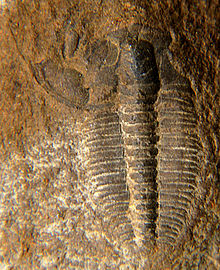Olenus (trilobite)
|
Olenus Temporal range: Upper Cambrian |
|
|---|---|
 |
|
| Olenus micrurus from Trawsfynned, N-Wales, right free cheek displaced to left and turned 150°, pygidium missing | |
| Scientific classification | |
| Kingdom: | Animalia |
| Phylum: | Arthropoda |
| Class: | Trilobita |
| Order: | Ptychopariida |
| Family: | Olenidae |
| Genus: |
Olenus Dalman, 1827 non Dejean, 1835 nomen nudum, ex Thomson, 1857 (= Trycherus, a beetle) |
| species | |
|
|
Olenus is a genus of Upper Cambrian ptychopariid trilobite.
The name Olenus refers to a mythological figure. His wife Lethaea claimed she was more beautiful than any goddess. To punish her for her vanity, she was turned to stone by the gods. Olenus could have avoided this fate, but chose to join his wife.
Olenus can be found in the British Isles, India, Norway, Sweden, Denmark, Newfoundland, Texas, South Korea, and Australia.
Fossils of Olenus are commonly found in dark mudstones, which were deposited on the seafloor in environments with low oxygen levels. The very wide side lobes (or pleurae) are thought to have shielded extended gills, which would have helped the animal absorb the maximum amount of oxygen possible in such an environment. Evidence also suggests that Olenus and its relatives may have developed a symbiotic relationship with sulfate-reducing bacteria, either by feeding on them or by absorbing nutrients directly from them.
Size: Up to 1.5 in (4 cm) long. It had up to 15 thoracic segments, with a narrow axis and wide pleurae.
...
Wikipedia
